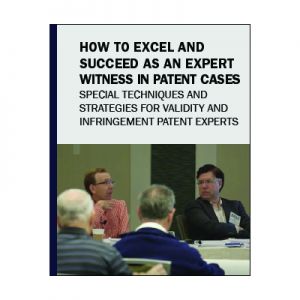Excerpted from SEAK’s Course: How to Excel as an Expert Witness in Patent Cases: Special Techniques
On the prior art side, this is where I find experts to be very helpful, would be what was, if we go back in time to the relevant invention date of, like, say, 1998, what other companies that were out there that are now defunct and nobody knows about, but in 1998, they were leading the charge on Bluetooth or LTE or something like that? Because we can send out subpoenas to try to get information from the individuals who were there. Or, if that company has been acquired and is now within some larger company, we can still try to get those documents. And that’s an area where, you know, we can do our best at a lot of digging. That’s what we try to pride ourselves in…at least at my firm, I’m trying to find those nuggets that are hidden out there. But it’s very helpful. We’ve had a lot of experts who have helped us identify companies and products that no one would have heard of, but we can go out and get information. I know of a case involving voice-over-internet protocol technology, where there was a protocol called, like, “Vocal Chat” or Vocal something that, if you were if you’re in this industry in the mid-early ’90s you knew about. And it’s been gone for a long time, but we were able to find the founders of the company. They’re over in Israel. We went and talked to them. They had all of their documents, and it became a really critical part of the case because they had all these documents and they had the product. They had the actual code for the product. So we were able to use that as a reference that anticipated the claims that were asserted at the time, or at least arguably anticipated it. So those are areas where we just don’t have the experience or we don’t know about it. Man 2: Let me give you a little example of that. So I was at IBM Research in the ’80s, and I developed a lot of the circuit board technology and substrate technology using the mainframe computers. About six months ago, an attorney called me and said, “I think you can answer a question for us. Do you know what the composition was of an IBM circuit board in 1986?” I said, “Yes, I can. I’ll send you my retainer agreement.” Right? Because I was probably one of the few people that were still available that could tell them what was involved in the circuit board. And it was a worker was claiming that exposure to chemicals and all that stuff making this product caused him all kinds of medical issues. So they needed to know what the composition was. Well, how would you find that if you couldn’t find somebody like me or somebody, you know, that was at Motorola, or way back. So sometimes you can provide pretty valuable insight to help the attorney with discovery.
